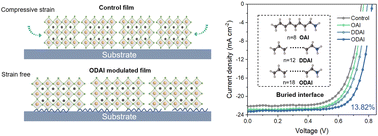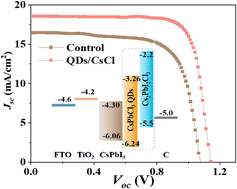Themed collection FOCUS: Recent Progress on Perovskite Solar Cells

Recent progress in organic–metal complexes for organic photovoltaic applications
Organic–metal complexes (OMCs) are endowed with new functions and properties due to the characteristics of valence changes of metal ions and the diversity of organic molecular structures.

Mater. Chem. Front., 2023,7, 5063-5103
https://doi.org/10.1039/D3QM00603D
Towards cost-efficient and stable perovskite solar cells and modules: utilization of self-assembled monolayers
Self-assembled monolayers (SAMs) are wonderful interfacial modification materials for adjusting the energy level and passivating the defects.

Mater. Chem. Front., 2023,7, 3958-3985
https://doi.org/10.1039/D3QM00209H
Magic guanidinium cations in perovskite solar cells: from bulk to interface
This review introduces the elementary properties of the GA-based perovskite and summarizes the development history of utilizing guanidinium materials in PSCs, along with proposing a perspective of future opportunities and challenges.

Mater. Chem. Front., 2023,7, 2507-2527
https://doi.org/10.1039/D2QM01315K
Phthalocyanine in perovskite solar cells: a review
This review critically analyses the chemical design and functionality of phthalocyanines in perovskite solar cells, which are generally applied in the perovskite layer, as the hole transport layer, or as an interlayer.

Mater. Chem. Front., 2023,7, 1704-1736
https://doi.org/10.1039/D2QM01369J
Small molecule dopant-free dual hole transporting material for conventional and inverted perovskite solar cells
Small molecule dopant-free HTL with the ability to self-assemble shows a dual performance that leads to very similar efficiencies in p–i–n and n–i–p perovskite solar cells.

Mater. Chem. Front., 2023,7, 4019-4028
https://doi.org/10.1039/D3QM00425B
Engineering the intermediate adduct phase to control the crystallization of perovskites for efficient and stable perovskite solar cells
This work provides a simple and effective method to improve the performance of perovskite solar cells by replacing DMSO with FAI. As a result, the crystallinity and morphology of the perovskite layer are improved, and a PCE of 20.79% resulted with higher long-term stability.

Mater. Chem. Front., 2023,7, 4080-4091
https://doi.org/10.1039/D3QM00537B
Underlayer engineering of grain strain toward efficient and stable tin perovskite solar cells
An underlayer engineering strategy was developed by introducing octadecanammonium iodide (ODAI) as a crystallization buffer molecule to release residual strain for efficient tin perovskite solar cells.

Mater. Chem. Front., 2023,7, 3406-3413
https://doi.org/10.1039/D3QM00236E
Spray-assisted deposition of a SnO2 electron transport bilayer for efficient inkjet-printed perovskite solar cells
A mesoporous SnO2-electron transport bilayer with a high surface-area-to-volume ratio is developed for application in inkjet-printed PSCs (IJP-PSCs). The use of SnO2-bilayer has uplifted the efficiency of IJP-PSCs up to a maximum of 16.9%.

Inorg. Chem. Front., 2023,10, 3558-3567
https://doi.org/10.1039/D3QI00599B
Interlayer engineering via alkaline hypophosphates for efficient and air-stable perovskite solar cells
Interlayer engineering via alkaline hypophosphates is used to improve the charge transport performance and device stability by adjusting energy band alignment and interfacial passivation, resulting in efficient and air-stable perovskite solar cells.

Mater. Chem. Front., 2023,7, 2426-2435
https://doi.org/10.1039/D3QM00103B
Understanding the synergistic influence of the propylammonium bromide additive and erbium-doped CsPbI2Br for highly stable inorganic perovskite solar cells
Inorganic cesium lead halide perovskites have gained increasing attention to boost photovoltaic performance and device stability.

Inorg. Chem. Front., 2023,10, 3213-3223
https://doi.org/10.1039/D2QI02448A
Low-cost and LiTFSI-free diphenylamine-substituted hole transporting materials for highly efficient perovskite solar cells and modules
A novel hole transporting material (SC-2) has been designed and synthesized. The pre-oxidized TFSI−salt has been synthesized and used as a p-dopant to achieve 21.3% power conversion efficiency for LiTFSI-free perovskite solar cells.

Mater. Chem. Front., 2023,7, 2241-2250
https://doi.org/10.1039/D2QM01330D
Harnessing solar energy with NH4Cl-doped hole transport layers in inverted perovskite solar cells
NH4Cl doped with PEDOT: PSS is pprepared with facile and efficient approach demonstrates a superior photovoltaic performance in inverted perovskite solar cells due to enhanced conductivity and light-harvesting ability.

Mater. Chem. Front., 2023,7, 1813-1820
https://doi.org/10.1039/D3QM00012E
Bridging the inter-grain charge transport via organic semiconductors for high-performance thickness-insensitive perovskite solar cells
The solution-processability of perovskite solar cells (PVSCs) reduces the production cost, but renders a multi-crystalline film with a large number of grain boundaries, which hinders the charge transport and induces defects.

Mater. Chem. Front., 2023,7, 1803-1812
https://doi.org/10.1039/D2QM01376B
Inhibiting Li+ migration by thenoyltrifluoroacetone toward efficient and stable perovskite solar cells
Thenoyltrifluoroacetone (TTA) modifies the perovskite/spiro-OMeTAD interface to inhibit Li+ migration from the hole transport layer to the perovskite layer and improves the performance of perovskite solar cells.

Inorg. Chem. Front., 2023,10, 2294-2303
https://doi.org/10.1039/D2QI02460H
Forming a composite electron blocking layer to enhance the performance of carbon-based CsPbI3 perovskite solar cells
Carbon-based CsPbI3 perovskite solar cells (C-PSCs) have attracted much interest due to their high chemical stability.

Mater. Chem. Front., 2023,7, 1617-1623
https://doi.org/10.1039/D2QM01124G
Efficient and stable hybrid conjugated polymer/perovskite quantum dot solar cells
Emerging lead halide perovskite quantum dots (QDs) have attracted great research interest relative to conventional metal chalcogenide-based QDs for applications like solar cells.

Mater. Chem. Front., 2023,7, 1423-1430
https://doi.org/10.1039/D3QM00015J
Interfacial engineering between SnO2/MAPbI3 by maleate pheniramine halides toward carbon counter electrode-based perovskite solar cells with 16.21% efficiency
Multifunctional complex molecules (CHM and BHM) were used to passivate interfacial defects, reduce the interfacial energy barrier, induce the orderly growth of perovskite crystals, and improve the PCE of HTL-free C-PSCs.

Mater. Chem. Front., 2023,7, 964-974
https://doi.org/10.1039/D2QM01149B
Polar side-chain tuning of perylene diimide and fluorene-based cathode interfacial material for high-performance inverted perovskite solar cells
Cathode interface layers (CILs) play an important role in inverted perovskite solar cells (PVSCs) to correct the mismatched energy levels, improve electron extraction, and passivate interfacial defects.

Mater. Chem. Front., 2023,7, 483-489
https://doi.org/10.1039/D2QM01088G
A thiourea resin polymer as a multifunctional modifier of the buried interface for efficient perovskite solar cells with reduced lead leakage
Thiourea resin can improve the connection performances and energy level matching of the buried SnO2/perovskite interface and suppress lead leakage through strong interactions.

Mater. Chem. Front., 2022,6, 3338-3348
https://doi.org/10.1039/D2QM00703G
Interplay of structural fluctuations and charge carrier dynamics is key for high performance of hybrid lead halide perovskites
Interplay of organic cation rotation and inorganic lattice fluctuation maintains the high performance of hybrid organic–inorganic perovskites.

Inorg. Chem. Front., 2022,9, 5549-5561
https://doi.org/10.1039/D2QI01482C
Bandgap tuning of a CsPbBr3 perovskite with synergistically improved quality via Sn2+ doping for high-performance carbon-based inorganic perovskite solar cells
Partially substituting Pb2+ with an appropriate amount of Sn2+ simultaneously reduces the bandgap and improves the quality and morphology of a CsPbBr3 perovskite film.

Inorg. Chem. Front., 2022,9, 4359-4368
https://doi.org/10.1039/D2QI00802E
About this collection
About this collection
Materials Chemistry Frontiers and Inorganic Chemistry Frontiers are delighted to introduce the following collection of articles on “Perovskite Solar Cells”. Access is free till 31 Oct. 2022.